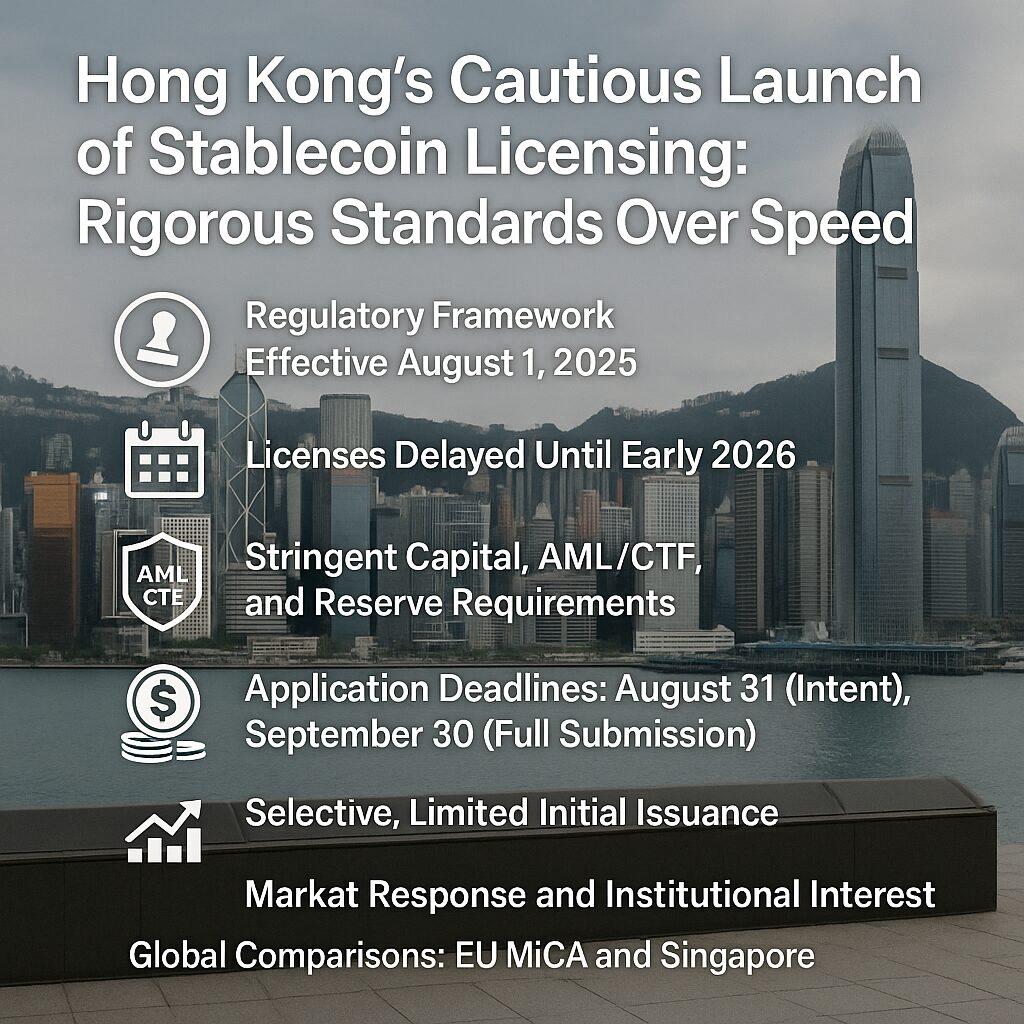
Main Points:
- Regulatory Framework Effective August 1, 2025
- Licenses Delayed Until Early 2026
- Stringent Capital, AML/CTF, and Reserve Requirements
- Application Deadlines: August 31 (Intent), September 30 (Full Submission)
- Selective, Limited Initial Issuance
- Market Response and Institutional Interest
- Global Comparisons: EU MiCA and Singapore SCS Framework

<Insert Figure 1 here: Timeline of HKMA Stablecoin Regulation Rollout** The figure above illustrates key dates from the regulation’s effective date through expected licensing. >
1. Regulatory Framework Effective August 1, 2025
On July 29, 2025, the Hong Kong Monetary Authority (HKMA) finalized its comprehensive stablecoin regulatory framework, which will come into force on August 1, 2025. This framework, embodied in the new Stablecoins Ordinance, establishes clear licensing requirements for any entity issuing fiat-referenced stablecoins (FRSs) in or from Hong Kong. By codifying these rules in the Gazette, the HKMA underscores its commitment to balancing innovation in digital assets with robust risk management.
2. Licenses Delayed Until Early 2026
Despite the regulation’s immediate effect, the HKMA has signaled that no licenses will be granted this year. Deputy CEO Darryl Chan Wai-man explained that the volume and complexity of applications necessitate a cautious approach, and the first stablecoin licenses are now expected in early 2026. This delay highlights Hong Kong’s prioritization of thorough vetting over rapid market rollout.
3. Stringent Capital, AML/CTF, and Reserve Requirements
The HKMA’s guidelines impose rigorous standards on prospective issuers:
- Capital and Operational Requirements: Issuers must meet minimum capital thresholds and demonstrate sound governance and operational capabilities.
- Anti-Money Laundering (AML) and Counter-Terrorist Financing (CTF): Two sets of guidelines mandate comprehensive customer due diligence, transaction monitoring, and suspicious activity reporting protocols.
- Reserves Transparency: Stablecoins must be backed 1:1 by high-quality liquid assets, with regular independent audits and public disclosures.
These measures aim to safeguard financial stability and investor protection by ensuring issuers maintain adequate liquidity and compliance controls.
4. Application Process and Timeline
To streamline the review process, the HKMA has established a phased application schedule:
- Expression of Interest (by August 31, 2025): Applicants must indicate their intent to apply and receive preliminary feedback.
- Full Application Submission (by September 30, 2025): Complete documentation—including technical, risk-management, and governance frameworks—must be provided.
- Licensing Decision (Expected Early 2026): After a detailed assessment, a limited number of licenses will be granted.
Institutions that miss these deadlines may face longer wait times, reinforcing the regulator’s preference for well-prepared applicants.
5. Selective, Limited Initial Issuance
Deputy CEO Chan emphasized that only a “handful” of licenses will be awarded in the initial batch. This selectivity serves to:
- Mitigate Systemic Risks: By limiting issuance, the HKMA can closely monitor market impact and issuer performance.
- Encourage High Standards: Only applicants demonstrating robust technical expertise and compliance frameworks will advance.
- Maintain Market Confidence: A controlled rollout reduces the likelihood of undercapitalized or operationally weak entities causing market disruptions.
6. Market Response and Institutional Interest
The licensing delay has elicited mixed reactions:
- Investor Caution: Some market participants view the postponement as a necessary safeguard, ensuring only credible issuers enter the market.
- Institutional Applications: Major players, such as Ant Group’s Ant International, have announced plans to apply, focusing on HKD- and USD-pegged stablecoins. Offshore yuan-backed proposals must clearly define use cases and reserve assets to pass muster.
- Stock Market Impact: Related stocks, like Guotai Junan International, surged following news of Hong Kong’s broader crypto services approvals, reflecting investor optimism in the city’s digital asset ambitions.
7. Global Comparisons: EU MiCA and Singapore SCS Framework
Hong Kong’s phased, stringent approach aligns with broader international trends:
- EU Markets in Crypto-Assets (MiCA): Effective June 2023, MiCA mandates 1:1 reserves, unified supervision, and issuer liability within the EU. However, a notable loophole permits fungible stablecoins issued outside the EU to circulate freely, raising systemic risk concerns.
- Singapore Single-Currency Stablecoin (SCS) Framework: Launched in August 2023, the Monetary Authority of Singapore (MAS) offers an “opt-in” regime focusing on value stability and liquidity standards for G10-pegged stablecoins.
By comparison, Hong Kong’s model combines the MiCA-like rigor of capital and reserve rules with Asia’s emphasis on controlled innovation, positioning the city as a responsible, yet competitive, digital asset hub.
Conclusion
Hong Kong’s deployment of its Stablecoins Ordinance demonstrates a clear strategy: prioritize safety and compliance over speed. By enforcing rigorous capital, AML/CTF, and reserve requirements—and by delaying initial license issuance until early 2026—the HKMA aims to cultivate a stablecoin ecosystem characterized by credible issuers and robust consumer protections. Market participants, from global financial giants to emerging fintech firms, must prepare comprehensive applications by the August and September deadlines to participate in this cautious yet forward-looking regulatory regime. As Hong Kong pursues its digital asset ambitions, its approach offers a compelling model for jurisdictions worldwide seeking to harness blockchain’s potential while safeguarding financial integrity.

